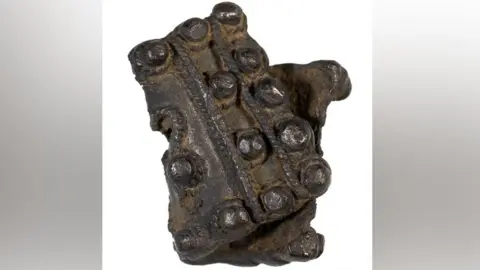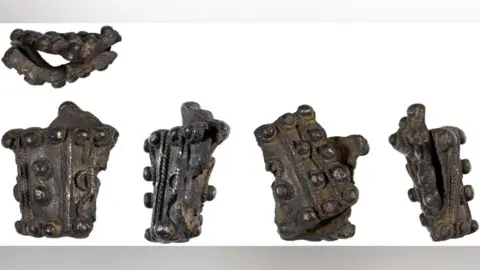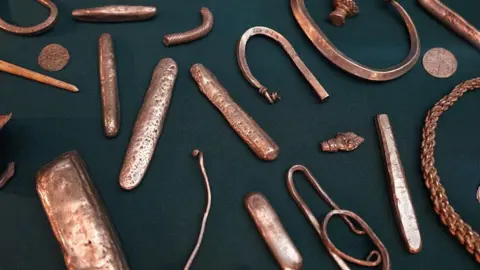Viking brooch 'only silver one found in England'
 Colchester and Ipswich Museum Service
Colchester and Ipswich Museum ServiceA rare 9th Century silver brooch has been linked to the greatest Viking silver treasure trove found outside Russia.
The piece of jewellery was discovered by a metal detectorist near Kelvedon, south of Braintree, in October 2023, and a coroner has declared it treasure.
Essex finds liaison officer Lori Richardson said it provided the first solid piece of evidence of Viking activity in this part of the county.
It was also "the only substantial silver example of this brooch type known from England", she added.
When a coroner rules that a discovery is treasure, a museum usually gets first refusal over whether to store it.
 Colchester and Ipswich Museum Service
Colchester and Ipswich Museum ServiceInitially, Miss Rogerson believed the incomplete brooch, which has folded in half over the centuries, was post-medieval.
"I looked through all my resources, I circulated it through all the curators - but none could claim it for their period of history," she said.
"Then I was looking at the Cuerdale Hoard and spotted fragments which reminded me of it and thought, 'Hang on a moment, it's one of those brooches' - and it became more exciting."
The hoard is made up of 8,600 items of silver coins and bullion and was unearthed near Preston, Lancashire, in 1840.
It is the greatest Viking silver treasure trove ever found, outside Russia.
 Getty Images
Getty ImagesMiss Rogerson's research revealed there were two other complete silver examples of the brooch, one found in Denmark and the other in The Netherlands.
A lead version has been found at the famous Coppergate Viking settlement in York.
"It is so rare, we don't have anything like it on the British Museum's Portable Antiquities database," said Miss Rogerson.
Metal detecting and the law
- No search can begin until permission has been given by the landowner
- All finds belong to the landowner
- Any find in England, Wales and Northern Ireland that is more than 300 years old, made of gold or silver, or found with gold or silver artefacts, could be treasure under the 1996 Treasure Act
- These must be reported to the appropriate county finds liaison officer
Source: Portable Antiquities Scheme
The discovery has also shed light on Viking movements in that part of Essex.
"Previously, we had had only slight suggestions of Viking activity here from a piece of possible hackgold, made from an object with Anglo-Saxon runes, and some Danish coins found in the late 19th Century," said Miss Rogerson.
Vikings armies were known to camp close to Anglo-Saxon settlements and would have found the River Blackwater "easily navigable".
"We know they navigated the River Blackwater during the Battle of Maldon in AD991, so the site of the find would have been a strategic one," she added.
Braintree Museum hopes to acquire the brooch.
Follow Essex news on BBC Sounds, Facebook, Instagram and X.
